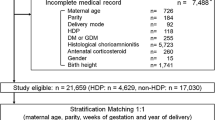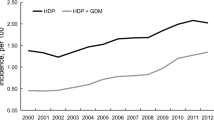Abstract
We designed a retrospective cohort study using the Diagnosis Procedure Combination database, a national inpatient database for acute-care inpatients in Japan, to examine whether recent global diagnostic criteria for preeclampsia, phenotypes of hypertensive disorders of pregnancy (HDP) and features of the disease are useful as predictors of placental abruption and whether other risk factors are associated with the onset of placental abruption. A total of 85,858 hospitalized patients with a diagnosis of HDP who gave birth during hospitalization between July 2010 and March 2018 were included in this study. We examined the associations between the occurrence of placental abruption after hospitalization and several factors, including gestational age (GA) at placental abruption onset, HDP subtypes, GA on admission, maternal age, body mass index, smoking, multiple pregnancy, prelabor rupture of membranes, diabetes mellitus, emergency admission by ambulance, and consciousness, using a multivariate logistic regression analysis. Placental abruption occurred in 541 patients (0.63%) after hospital admission, and the occurrence increased acutely after 32 weeks GA. A decrease in abruption was significantly associated with maternal BMI on admission (≥30 kg/m2; odds ratio [OR], 0.54; 95% confidence interval [CI], 0.41–0.70) and multiple pregnancy (OR, 0.29; 95% CI, 0.18–0.46). An increase in abruption was associated with earlier GA on admission (<34 weeks’ GA; OR, 3.77; 95% CI, 3.13–4.53) and emergency admission by ambulance (OR, 1.34; 95% CI, 1.09–1.65). Individual features of severe PE showed no significant associations with the occurrence of abruption. In conclusion, HDP at an earlier GA was suggested to be a risk factor for placental abruption, and we recommend hospitalization and careful management of such patients to improve their prognosis.
This is a preview of subscription content, access via your institution
Access options
Subscribe to this journal
Receive 12 print issues and online access
$259.00 per year
only $21.58 per issue
Buy this article
- Purchase on Springer Link
- Instant access to full article PDF
Prices may be subject to local taxes which are calculated during checkout


Similar content being viewed by others
References
Hasegawa J, Toyokawa S, Ikenoue T, Asano Y, Satoh S, Ikeda T, et al. Relevant obstetric factors for cerebral palsy: from the Nationwide Obstetric Compensation System in Japan. PLoS ONE. 2016;11:e0148122.
Ananth CV, Lavery JA, Vintzileos AM, Skupski DW, Varner M, Saade G, et al. Severe placental abruption: clinical definition and associations with maternal complications. Am J Obstet Gynecol. 2016;214:272.e1–272.e9.
Ananth CV, Smulian JC, Demissie K, Vintzileos AM, Knuppel RA. Placental abruption among singleton and twin births in the United States: risk factor profiles. Am J Epidemiol. 2001;153:771–8.
Ukah UV, De Silva DA, Payne B, Magee LA, Hutcheon JA, Brown H, et al. Prediction of adverse maternal outcomes from pre-eclampsia and other hypertensive disorders of pregnancy: a systematic review. Pregnancy Hypertens. 2018;11:115–23.
Brown MA, Magee LA, Kenny LC, Karumanchi SA, McCarthy FP, Saito S, et al. Hypertensive disorders of pregnancy: ISSHP classification, diagnosis, and management recommendations for international practice. Hypertension. 2018;72:24–43.
Visintin C, Mugglestone MA, Almerie MQ, Nherera LM, James D, Walkinshaw S, et al. Management of hypertensive disorders during pregnancy: summary of NICE guidance. BMJ. 2010;341:c2207.
Makino S, Takeda J, Takeda S, Watanabe K, Matsubara K, Nakamoto O, et al. New definition and classification of hypertensive disorders of pregnancy (HDP). Hypertens Res Pregnancy. 2019;7:1–5.
Matsui H, Jo T, Fushimi K, Yasunaga H. Outcomes after early and delayed rehabilitation for exacerbation of chronic obstructive pulmonary disease: a nationwide retrospective cohort study in Japan. Respir Res. 2017;18:68.
Yamana H, Moriwaki M, Horiguchi H, Kodan M, Fushimi K, Yasunaga H. Validity of diagnoses, procedures, and laboratory data in Japanese administrative data. J Epidemiol. 2017;27:476–82.
Shigematsu K, Nakano H, Watanabe Y. The eye response test alone is sufficient to predict stroke outcome–reintroduction of Japan Coma Scale: a cohort study. BMJ Open. 2013;3:e002736.
Ananth CV, Savitz DA, Williams MA. Placental abruption and its association with hypertension and prolonged rupture of membranes: a methodologic review and meta-analysis. Obstet Gynecol. 1996;88:309–18.
Buchbinder A, Sibai BM, Caritis S, Macpherson C, Hauth J, Lindheimer MD, et al. Adverse perinatal outcomes are significantly higher in severe gestational hypertension than in mild preeclampsia. Am J Obstet Gynecol. 2002;186:66–71.
Guo Q, Feng P, Yu Q, Zhu W, Hu H, Chen X, et al. Associations of systolic blood pressure trajectories during pregnancy and risk of adverse perinatal outcomes. Hypertens Res. 2020;43:227–34.
MacKay AP, Berg CJ, Atrash HK. Pregnancy-related mortality from preeclampsia and eclampsia. Obstet Gynecol. 2001;97:533–8.
von Dadelszen P, Menzies JM, Payne B, Magee LA, Group PS. Predicting adverse outcomes in women with severe pre-eclampsia. Semin Perinatol. 2009;33:152–7.
Rolnik DL, Wright D, Poon LC, O’Gorman N, Syngelaki A, de Paco Matallana C, et al. Aspirin versus placebo in pregnancies at high risk for preterm preeclampsia. N Engl J Med. 2017;377:613–22.
Turner JM, Robertson NT, Hartel G, Kumar S. Impact of low-dose aspirin on adverse perinatal outcome: meta-analysis and meta-regression. Ultrasound Obstet Gynecol. 2020;55:157–69.
Haddad B, Sibai BM. Expectant management in pregnancies with severe pre-eclampsia. Semin Perinatol. 2009;33:143–51.
Churchill D, Duley L, Thornton JG, Moussa M, Ali HS, Walker KF. Interventionist versus expectant care for severe pre-eclampsia between 24 and 34 weeks’ gestation. Cochrane Database Syst Rev. 2018;10:CD003106.
Tokumasu H, Tokumasu S, Kawakami K. Impact of pre-eclampsia in extremely premature infants: population-based study. Pediatr Int. 2016;58:578–83.
Meher S, Abalos E, Carroli G. Bed rest with or without hospitalisation for hypertension during pregnancy. Cochrane Database Syst Rev. 2005;4:CD003514.
Minakami H, Maeda T, Fujii T, Hamada H, Iitsuka Y, Itakura A, et al. Guidelines for Obstetrical Practice in Japan: Japan Society of Obstetrics and Gynecology (JSOG) and Japan Association of Obstetricians and Gynecologists (JAOG) 2014 Edition. J Obstet Gynaecol Res. 2014;40:1469–99.
Adane AA, Shepherd CCJ, Lim FJ, White SW, Farrant BM, Bailey HD. The impact of pre-pregnancy body mass index and gestational weight gain on placental abruption risk: a systematic review and meta-analysis. Arch Gynecol Obstet. 2019;300:1201–10.
Acknowledgements
This work was supported by grants from the Ministry of Health, Labour and Welfare, Japan (19AA2007 and 20AA2005) and the Ministry of Education, Culture, Sports, Science and Technology, Japan (20H03907).
Members for the Advanced Life Support in Obstetrics (ALSO)-Japan Research Group
Ichiro Yasuhi6, Yasuhiko Ozaki7, Akiko Sakajo8, Atsushi Tajima9, Seiji Tsutsumi10, Satoru Nakayama11, Teruyuki Yamasaki12, Satoshi Nakago13, Yuji Hiramatsu14, Junko Mochizuki15, Mikio Hashiguchi16, Katsuhiko Naruse17, Takanari Arai18
Author information
Authors and Affiliations
Consortia
Corresponding author
Ethics declarations
Conflict of interest
The authors declare that they have no conflict of interest.
Additional information
Publisher’s note Springer Nature remains neutral with regard to jurisdictional claims in published maps and institutional affiliations.
Members for the Advanced Life Support in Obstetrics (ALSO)-Japan Research Group are listed below Acknowledgements.
Rights and permissions
About this article
Cite this article
Naruse, K., Shigemi, D., Hashiguchi, M. et al. Placental abruption in each hypertensive disorders of pregnancy phenotype: a retrospective cohort study using a national inpatient database in Japan. Hypertens Res 44, 232–238 (2021). https://doi.org/10.1038/s41440-020-00537-6
Received:
Revised:
Accepted:
Published:
Issue Date:
DOI: https://doi.org/10.1038/s41440-020-00537-6



